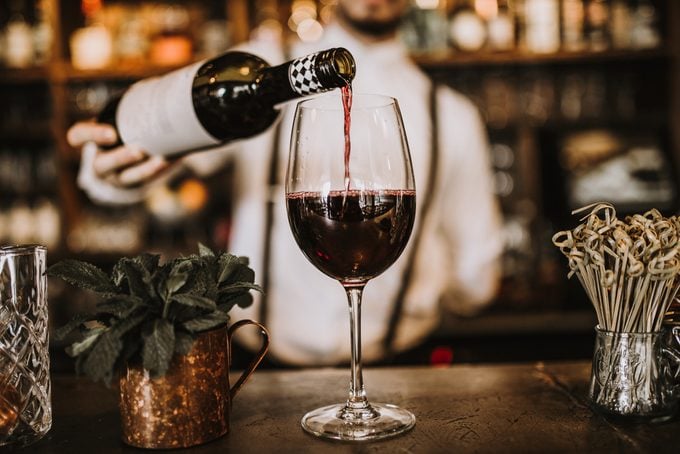This Is Why Wine Is So Expensive in Restaurants
Updated: Feb. 10, 2021
Wine prices double the moment you walk through a restaurant's door. Here are the restaurants have the highest markups and how to find a decent value.

When you sit down at a restaurant, first things first: You want to set the mood for the evening with a bottle of wine. But a glance at the prices can be enough to make you say, “Just tap water, please.” These days, a bottle of vino will cost at least as much as entrees for two. And just to rub salt in your all-too-sober wound, that bottle would cost a fraction of the menu price if you had picked it up from the liquor store around the block.
While even the price of the same wine can vary from restaurant to restaurant, the rule of thumb is that most places will mark their bottles up to around three times the wholesale price—around double the price you’d pay at the store. You’ll see even bigger price hikes on the by-the-glass options. If you thought that was bad, you’ll be shocked by the most overpriced foods on restaurant menus.
Of course, the first piece of the price puzzle comes down to supply and demand: Restaurants can charge you more because they know you’ll pay it. That’s even truer for glasses than for bottles. A good deal of guests won’t want to shell out for a whole bottle (especially if they’re driving home), so restaurants squeak those prices up a notch, knowing full well that someone who just wants one glass isn’t about to pay extra for a whole bottle just for the sake of per-ounce value.
The idea of wanting to make a profit off wine isn’t exactly earth-shattering, but what you might not realize is just how important the drinks list is to a restaurant’s bottom line. In most cases, restaurants make most of their profits from drinks rather than food, according to the New York Post. Entrée prices are more competitive—customers might walk past a place where mains start at $20 if they can pay $12 somewhere else—but most people aren’t basing their restaurant choice on the wine list. Businesses know that and are likely to hike drink prices up before touching the food fees. For both food and drinks, use these 11 tips for saving money at restaurants.
Still, different restaurants sometimes have wildly different price points for the same bottle; a wine worth $15 retail could cost $25 one place and $40 another. Part of that has to do with expectations of a restaurant. A trendy restaurant with valets and sommeliers can charge more because, to a degree, customers are paying for atmosphere. Meanwhile, a casual restaurant with a small staff has less overhead and can afford to keep drink costs down without losing profit. Keep in mind that you aren’t just paying for the wine itself like you would at home. In a restaurant, you’re also paying for storage, plus servers to cork and pour, and bussers and dishwashers to clean up after you.
If you’re looking for low markups (and not just the lowest prices), here’s a little secret: The biggest markups tend to be on the cheapest bottles. It makes sense; while you wouldn’t blink at a $30 restaurant bottle that the restaurant paid $5 for, paying six times the usual cost of a $30 just isn’t going to happen for the casual customer, sommolier Mark Oldman explains in his book, How to Drink Like a Billionaire, according to Business Insider.
Restaurants also can charge a premium for big sellers like Merlot and Chardonnay. Customers are likely to stick with what they know instead of blindly ordering an Austrian Blaufränkisch, so the tried-and-true favorites tend to have higher markups. If you have the budget for it, getting a wine a bit farther up the price list, especially if it’s from a less-known region or variety, will probably give you the best quality for the best value, according to Food & Wine. While you’re at it, learn which 15 things you should never eat at restaurants.